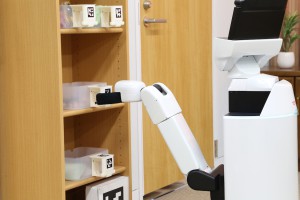
Toyota's Human Service Robot is currently being tested and used in medical settings to help tend to the needs of patients.
Automakers have been using robots to help produce cars and trucks for decades, but now Toyota appears poised to turn the tables and begin producing robots with hopes of being a dominant player in that segment too.
The Japanese maker now has developed what it calls a “partner robot” designed to help human with simple, mundane tasks that ideally allows people to be more efficient or to improve their quality of life. The company feels strongly enough about the prospects that its created a division dedicated to the development.
“We are preparing for a future in which people may not be able to drive cars, or they may need artificial intelligence to support them to drive, and once they get off their cars they may need help from partner robots,” Akifumi Tamaoki, general manager of Toyota’s partner robot division, told the Associated Press.
Toyota isn’t the only automaker with robot ambitions. Honda has ASIMO, which it has been developing for more than a decade, and more recently Yamaha introduced its new Motobot, the first motorcycle-riding robot.
Much of those efforts have been aimed improving the safety of driving. However, Toyota has been expanding its focus recently to include service robots.

Toyota's HSR, also known as a partner robot, possesses the ability to handle a variety of tasks, including picking up paper off the floor.
(Toyota investing $1 billion in U.S. artificial intelligence center. For more, Click Here.)
The maker recently opened the $1 billion Toyota Research Institute Inc. with offices in Silicon Valley and Cambridge, Massachusetts. The new enterprise will not only on develop ways to make driving safer, but also on technology that can improve the lives of the elderly and disabled.
Tamaoki reconfirmed that company’s interest is beyond simply improving driving during an appearance at robotics show in Japan earlier this week. The facility should also pay dividends by improving production technologies, an area in which Toyota has long been the benchmark manufacturer.
The new Toyota Research Institute will act as a bridge between advanced research and practical applications, according to the automaker. Pratt, who will run the operation, was a pioneer in robotics and autonomous vehicle research.
He previously led the Defense Department’s DARPA Robotics Challenge that focused on the development of semi-autonomous robots that could perform complex tasks in dangerous environments.
The new facility will be up and running by 2016 and hopes to draw researchers and engineers from major universities including MIT and Stanford. Toyota recently announced a joint effort with those two learning centers, each receiving $50 million AI grants.
(Click Here to get details about Toyota’s Human Service Robot.)
“As technology continues to progress, so does our ability to improve products,” said CEO Toyoda. “At Toyota, we do not pursue innovation simply because we can; we pursue it because we should. It is our responsibility to make life better for our customers, and society as a whole.”
To that end, the HSR has been up-and-running since 2012 with Toyota making improvements along the way. Currently, its highly maneuverable, compact, and lightweight cylindrical body and folding arm, the HSR can pick objects up off the floor, retrieve objects from shelves, and perform a variety of other tasks.
With the goal of assisting independent home living for the elderly and disabled, Toyota is teaming up with a number of research institutes to found the HSR Developers’ Community. This institute will put forth a cooperative effort to hasten the development and early practical adoption of the HSR.
Toyota’s HSRs range in height from 3-foot 3-inches tall to 4-foot 4.5-inches tall. While less human looking than ASIMO, the HSR has more practical applications right now. Not all of Toyota’s robotic efforts have been so dedicated to improving the lives of humans.
Looking like a character walking off the screen from a Japanese anime film, Toyota introduced Kirobo Mini, a downsized version of the talking robot that Toyota built for use on the International Space Station, during the Tokyo Motor Show earlier this year.
(To see more about Toyota’s robotic collaboration with MIT, Stanford, Click Here.)
“Kirobo Mini was created to be able to accompany its owners everywhere and communicate with them in a meaningful way,” explains Toyota’s news release, adding that, “Our aim is for Kirobo Mini to communicate with people through expressions and gestures, bringing smiles to their faces through daily exchanges that chart the course of an evolving relationship.”
